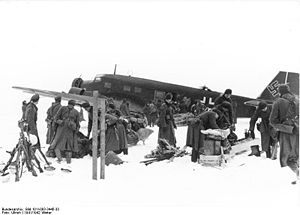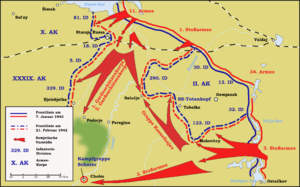- Demyansk Pocket
-
Demyansk Pocket Part of World War II 
Date 8 February 1942-March 1942 Location Demyansk, Russia Result German defensive success Belligerents  Germany
Germany Soviet Union
Soviet UnionCommanders and leaders  Walter von Brockdorff-Ahlefeldt
Walter von Brockdorff-Ahlefeldt
 Walther von Seydlitz-Kurzbach
Walther von Seydlitz-Kurzbach Andrey Vlasov[citation needed]
Andrey Vlasov[citation needed]Strength unknown unknown Casualties and losses unknown unknown Naval warfare
Baltic Sea - Black Sea - Arctic - (Arctic Convoys - Rösselsprung - Wunderland)
1941
Barbarossa - (Białystok and Minsk - Smolensk - Uman - Leningrad - 1st Kiev - Sevastopol - Rostov - Moscow) - Finland - Chechnya
1942
Battles of Rzhev - (Toropets and Kholm - Demyansk - Velikiye Luki - Mars) - 2nd Kharkov - Case Blue - Stalingrad - (Uranus - Winter Storm)
1943
3rd Kharkov - Kursk - 2nd Smolensk - Lower Dnieper - 2nd Kiev
1944
Dnieper and Carpathian - Leningrad and Novgorod - Narva - Hube's Pocket - Crimea - Jassy-Kishinev - Karelia - Bagration - Lvov and Sandomierz - 2nd Jassy-Kishinev - Baltics - Debrecen - Petsamo and Kirkenes - Hungary
1945
Vistula and Oder - East Prussia - East Pomerania - Solstice - Silesia - Vienna - Berlin - Czechoslovakia - German capitulationLeningrad and the Baltics 1941–1944June in Lithuania – Summer in Estonia – Evacuation of Tallinn – Nazi occupation – Toropets-Kholm – Demyansk – Sinyavino – Iskra – Polyarnaya Zvezda – Relief of the siege – Narva – Karelian isthmus – Vilnius – Kaunas – Southern Estonia – Riga – Northern Estonia – Attempt to restore independence of Estonia – Moonsund – Re-occupation of Estonia – Courland – Re-occupation of LatviaThe Demyansk Pocket (German: Festung Demjansk or Kessel von Demjansk; Russian: Демя́нский котёл) was the name given for the encirclement of German troops by the Red Army around Demyansk (Demjansk), south of Leningrad, during World War II on the Eastern Front. The pocket existed mainly from 8 February-21 April 1942. A much smaller pocket was simultaneously surrounded in Kholm, about 100 km (62 mi) to the southwest. These were the results of German retreat following their defeat during the Battle of Moscow.
Contents
Encirclement
The encirclement began as the Demyansk Offensive Operation, the first phase being carried out from 7 January-20 May 1942 on the initiative of General Lieutenant Pavel Kurochkin, commander of Northwestern Front. The intention was to sever the link between the German Demyansk positions, and the Staraya Russa railway that formed the lines of communication of the German 16. Armee. However, owing to the very difficult wooded and swampy terrain, and heavy snow cover, the initial advance by the Front was very modest against stubborn opposition.
On 8 January, a new offensive called the Rzhev-Vyazma Strategic Offensive Operation started. This incorporated the previous Front's planning into the Toropets-Kholm Offensive Operation between 9 January and 6 February 1942 which formed the southern pincer of the attack that, beginning the second phase of the northern pincer Demyansk Offensive Operation between 7 January and 20 May, which encircled the German 16th Army's (Generaloberst Ernst Busch) IInd, and parts of the Xth Army Corps (General der Artillerie Christian Hansen) during winter 1941/1942.
Trapped in the pocket were the 12th, 30th, 32nd, 123rd and 290th infantry divisions, and the SS-Division Totenkopf, as well as RAD, Police, Todt organization and other auxiliary units, for a total of about 90,000 German troops and around 10,000 auxiliaries. Their commander was General der Infanterie Walter Graf von Brockdorff-Ahlefeldt, commander of the IInd Army Corps.
Northwestern Front offensives
The intent of the Northwestern Front offensive was to encircle the entire northern flank of the 16th Army's forces, of which the 2nd Army Corps was only a small part, and the Soviet command was desperate to keep the Front moving even after this success. The first thrust was made by the 11th Army, 1st Shock Army and the 1st and 2nd Guards Rifle Corps released for the operation from Stavka reserve. A second thrust was executed on 12 February by the 3rd and 4th Shock Armies of the Kalinin Front, with the additional plan of directly attacking the encircled German forces by inserting two airborne brigades to support the advance of the 34th Army. The front soon settled as the Soviet offensive petered out due to difficult terrain and bad weather.
After being assured that the pocket could be supplied with its daily requirement of 270 short tons (240 t) of supplies by Luftflotte 1, Hitler ordered that the surrounded divisions hold their positions until relieved. The pocket contained two fairly capable airfields at Demyansk and Peski. From the middle of February, the weather improved significantly, and while there was still considerable snow on the ground at this time, resupply operations were generally very successful due to weakness of the Red Air Forces in the area. However the operation did use up all of the Luftwaffe's transport capability, as well as elements of their bomber force.
The Northwestern Front grew increasingly desperate to wipe out the pocket, and over the winter and spring, launched a number of assaults on the "Ramushevo corridor" that formed the tenuous link between Demyansk and Staraya Russa through the Ramushevo village that were repeatedly repulsed. In total, five Soviet Armies composed of 18 rifle divisions and three brigades were tied up for four months.[citation needed]
However, by the end of May, the Stavka reconsidered the overall situation and decided to shift its attention to the Moscow sector, where a new German offensive was expected in the summer.
Attempted breakout
On 21 March 1942, German forces under the command of Generalleutnant Walther von Seydlitz-Kurzbach attempted to leave through the "Ramushevo corridor". Over the next several weeks, this corridor was widened. A battle group was able to break out of the siege on 21 April, but the fighting had taken a heavy toll. Out of the approximately 100,000 men trapped, there were 3,335 lost and over 10,000 wounded. However, their strong resistance had tied up numerous Soviet units at a critical moment, units that could have been used elsewhere. Instrumental in the German breakout, was the first time use of the Mkb-42(H), which would later be re-designated the MP-43 and then finally the Mp-44.
Between the forming of the pocket in early February to the virtual abandonment of Demyansk in May, the two pockets (including Kholm) received 65,000 short tons (59,000 t) of supplies (both through ground and aerial delivery), 31,000 replacement troops, and 36,000 wounded were evacuated. However, the cost was significant. The Luftwaffe lost 265 aircraft, including 106 Junkers Ju 52, 17 Heinkel He 111 and two Junkers Ju 86 aircraft. In addition, 387 airmen were lost.[1]
The Soviet Air Forces lost 408 aircraft, including 243 fighters, in a bid to crush the pocket.
Fighting in the area continued until 28 February 1943. The Soviets did not liberate Demyansk until 1 March 1943, with the retreat of the German troops. For his excellence in command and the particularly fierce fighting of his elite unit, 3. SS Division Totenkopf, SS-Obergruppenführer Theodor Eicke was the 88th person to be awarded the Oak Leaves to the Knight's Cross on 20 May 1942.
The success of the Luftwaffe convinced Reichsmarschall Hermann Göring and Hitler that they could conduct effective airlift operations on the Eastern front.[1] Göring later proposed a similar "solution" to supply the 6. Armee when it was surrounded in Stalingrad. In theory, the outcome could be equally advantageous; with the 6. Armee trapped, but still in fighting condition, the Soviet army would have to use up much of its strength to keep the pocket contained. This could allow other German forces to re-group and mount a counterattack. However, the scale of the forces trapped in the two operations differed greatly. While a single corps (about ⅓ of an army) with about six divisions was encircled in Demyansk, in Stalingrad, an entire and greatly reinforced army was trapped. Whereas the Demyansk and Kholm pockets together needed around 265 t (292 short tons) of supplies per day, the 6. Armee required an estimated daily minimum of 800 t (880 short tons), delivered over a much-longer distance and faced by a much better organised Red Air Force. The air transport force had already suffered heavy losses, and was much further away from good infrastructure. The Luftwaffe simply did not have the resources needed to supply Stalingrad.
References
- Bergstrom, Christer (2007). Stalingrad - The Air Battle: November 1942 - February 1943. London: Chervron/Ian Allen. ISBN 978-1-85780-276-4.
- Kurowski, Franz (2001). Demjansk Der Kessel im Eis. Wölfersheim-Berstadt: PODZUN-PALLAS. ISBN 3-7909-0718-9.
- http://victory.mil.ru/lib/books/h/nwf/index.html Сборник. На Северо-Западном фронте — М.: «Наука», 1969 (Вторая Мировая война в исследованиях, воспоминаниях, документах) Институт военной истории Министерства Обороны СССР; под редакцией и с предисловием члена-корреспондента АН СССР генерал-лейтенанта П. А. Жилина; cоставил и подготовил сборник кандидат военных наук, доцент, полковник Ф. Н. Утенков; научно-техническая работа проведена подполковником В. С. Кислинским.
- Group of authors, A collection. On the North-Western Front, Moscow, Science (pub.), 1969 (Second World War in research, memoirs, documents), Institute of military history of Ministry of Defence of USSR, edited and with forward by member-correspondent AN SSR, General-lieutenant P.A. Zhilin; compiled and prepared for publication by candidate of military sciences, dozent, Colonel F.N. Utenkov, scientific-technical work undertaken by Sub-colonel V.S. Kislinsky
External links
 Media related to Battle of Demiansk at Wikimedia Commons
Media related to Battle of Demiansk at Wikimedia Commons
Categories:- Conflicts in 1942
- Military operations of World War II involving Germany
- Battles and operations of the Soviet–German War
Wikimedia Foundation. 2010.


